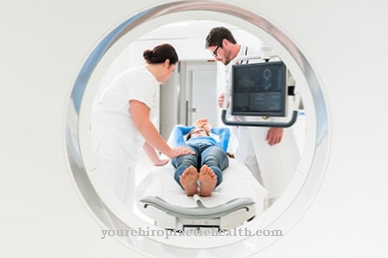Increased fat levels in the blood in medicine denote an increase in the body's own blood lipids, cholesterol and triglyceride. Permanently too high values can lead to vascular calcification and, in the long term, lead to a heart attack or stroke. The causes lie in the congenital predisposition as well as in the individual lifestyle.
What are elevated blood lipid levels?

© Axel Kock - stock.adobe.com
The substances cholesterol and triglyceride are basically present in the human body because they are involved in vital functions.
However, if the normal values of these so-called blood lipids are exceeded, there is a risk of serious and possibly even life-threatening diseases. These result from deposits in the vessels, which are caused by the excessive concentration of blood lipids.
The values increase, among other things, due to an unbalanced diet and lifestyle. Elevated blood lipids themselves usually do not cause any symptoms and are not infrequently only noticed when a secondary disease has already occurred. Regular blood tests can provide information on whether there is an increase in blood lipid levels and whether treatment is required.
causes
The causes of increased blood lipid levels are partly due to a congenital predisposition. For example, some patients suffer from a metabolic disorder in which the cholesterol cannot be broken down in the liver as usual.
In the majority of cases, however, the increased blood lipid levels are due to the individual lifestyle of the person concerned. Obesity, diabetes, and regular alcohol consumption can all drive up levels.
The consumption of animal fat, for example in the form of fatty meat or eggs, can contribute to a permanent increase in blood lipid levels and, as a result, medical treatment becomes necessary.
Symptoms, ailments & signs
Increased blood lipid levels usually do not cause any clear symptoms or complaints at the beginning. Only when they persist for a longer period of time will there be clear signs and, in the further course, serious complications. If elevated blood lipid levels are not treated, they also lead to increased cholesterol in the long term, combined with obesity, circulatory disorders and an increased risk of heart attack and stroke.
In addition, a fatty liver develops, which in turn is associated with a variety of symptoms - for example jaundice, chronic pain and loss of performance. Accompanying this can lead to hardening of the arteries, which is noticeable, among other things, in speech disorders, body aches, paralysis and chest pain. In the long run, increased blood lipid levels also have a negative effect on well-being.
Those affected usually feel ill and are less productive overall. Difficulty concentrating, tiredness and fatigue as well as dizziness can occur. In the later stages of the disease, life-threatening complications such as heartbeat and stroke cannot be ruled out.
Elevated blood lipids cannot be seen externally. However, they mostly occur in connection with weight problems and a generally unhealthy lifestyle. To avoid serious consequences, you should see a doctor if the symptoms and complaints mentioned occur.
Diagnosis & course
Elevated blood lipid levels are usually determined by the attending physician. As part of a laboratory blood test, it can be determined exactly whether there are elevated values, what these are and how drastic the increase is.
Such blood tests should take place regularly, especially if there are risk factors such as obesity, sedentary lifestyle or diabetes. The following applies: the more risk factors there are, the lower the blood lipid values should be in order to avoid serious secondary diseases.
If elevated blood lipid levels remain untreated, the vessels in the body increasingly calcify. As a result, there may be life-threatening diseases such as heart attack, stroke or fatty liver disease.
When should you go to the doctor?
Elevated blood lipid levels and elevated cholesterol levels are the main risk factors for hardening of the arteries and can promote heart attack, stroke and even arterial occlusive disease. Therefore, they should always be examined by a doctor, they can be a symptom of various diseases, and early treatment improves the chances of recovery.
People who are very overweight, have gout and diabetes in particular should be examined more closely because elevated blood lipid levels cannot be recognized by typical symptoms; only a blood count can provide information. The examination can be carried out by a general practitioner, who can also handle the treatment if necessary. Kidney and liver problems should also be examined by a doctor. In some cases, elevated blood lipid levels can also cause muscle pain and muscle wasting, which should also be examined and treated by a doctor.
Affected people can also do a lot to improve their health themselves, because the main cause is usually an unhealthy lifestyle and poor diet. A doctor may recommend an individually tailored nutritional program that the patient can test for several weeks. The blood lipid levels are then checked again. In addition, it is important to limit your alcohol consumption and get enough exercise to improve fat burning. If these measures are not sufficient, he can also prescribe medication.
Doctors & therapists in your area
Treatment & Therapy
If the blood lipid levels are only recently or not yet significantly increased, the person concerned can try to lower them with some lifestyle changes. This includes regular exercise and the reduction of excess weight as well as a diet in which the body only receives a few animal fats.
Often an improvement in blood lipid levels can already be achieved in this way. According to statistics, the values decrease by up to 30% when lifestyle adjustments are made. However, if the attending physician determines that the blood lipid levels are not falling, they will also initiate drug therapy. There are different alternatives that are more or less suitable depending on the individual medical history.
For example, the body's own production of cholesterol can be reduced, which leads to a general decrease in blood lipid levels. Alternatively, drugs are used that convert cholesterol into bile acid. The doctor and patient should ideally find out which medication is used in a detailed discussion.
In particularly severe cases, blood washing can be carried out in order to regulate the blood lipid level in the organism. However, such a procedure is very rarely necessary. Usually very good results are achieved through drug therapy. A regular check of the blood values is recommended in any case.
Outlook & forecast
The prognosis for hyperlipidemia depends on several factors. The influencing factors include the individual values of cholesterol and triglyceride, the lifestyle of the person affected, previous illnesses and the age of the patient.
With a good and balanced diet, sufficient sporting activities and a healthy lifestyle, the increased blood lipid levels can in many cases be reduced even without medical treatment. Obesity and regular consumption of alcohol should be avoided in order to improve health.
If there is an illness, the prognosis often worsens. In the case of a congenital disorder of the metabolism or diabetes, the patient needs long-term therapy or lifelong drug treatment. The blood lipid levels have to be checked regularly and corrected by the administration of medicines.
By optimizing the diet, the symptoms can be alleviated despite a diagnosed underlying disease. The consumption of animal fats through fatty meat or eggs should be reduced or avoided so that blood lipid levels drop.
If the hyperlipidemia remains unnoticed or untreated for a long time, the prognosis worsens. The vessels in the organism begin to calcify and circulatory disorders set in. In severe cases, a heart attack or stroke threatens life-threatening or fatal conditions.
prevention
Since elevated blood lipid levels often result from personal lifestyle, it is advisable to ensure sufficient exercise and a balanced diet from the outset. Avoiding stimulants such as alcohol and nicotine and avoiding obesity can also help to keep blood lipid levels at a normal level. To check this, it is advisable to have regular blood tests. This can prevent the occurrence of serious secondary diseases.
Aftercare
Elevated blood lipids are dangerous. You must therefore remain under observation. What is difficult for aftercare is that the organism can produce cholesterol itself and ensure high blood lipid levels.
Those affected should try to improve their blood lipid levels through a healthy, low-fat and animal-product-poor diet and sufficient exercise. If this is not possible, drug treatment must be considered. The aim of follow-up care must be to prevent the development of a metabolic syndrome and all of its health consequences.
For overweight and obese people, follow-up care must aim at losing weight. If necessary, a hospital stay with this aim is useful. Patients who have been treated for Hodgkin's syndrome may experience long-term effects from the therapy if they are cancer-free. These can affect different organs.
It is therefore advisable to send these patients to long-term follow-up. Particular attention should be paid to increased blood lipid levels, obesity or diabetes. The reason is an increased risk of heart problems as a result of treatment in later years.
The same obligation to provide long-term follow-up care applies to other cancers that have been treated in children, adolescents or adults. Increased blood lipid levels represent a risk maximization that should be avoided.
You can do that yourself
Elevated blood lipid levels can cause vascular calcification and, in the medium to long term, lead to a heart attack or stroke. In some people affected, the elevated blood lipid levels can be traced back to constitutional metabolic disorders. In the vast majority of cases, however, the disorder results from the patient's lifestyle. Obesity, diabetes and lack of exercise lead to high cholesterol and triglyceride levels. As a rule, however, an incorrect diet has the greatest influence.
Those affected help themselves best if they consistently change their way of life and diet. This is not always easy and should be done gradually. The best thing to do is to get support from a trained nutritionist. In almost all cases, too high a proportion of animal foods is the reason for the high blood lipid levels.
Those affected should then become familiar with the benefits of a plant-based diet. As a rule, it is not necessary to completely renounce your favorite dishes, but a drastic reduction in the intake of animal fats is unavoidable. Many people affected are helped by substitute products that smell and taste like meat or sausage, but actually contain little or no animal components.
Anyone who has no experience with such products can seek advice from specialist retailers. Vegan mail order companies, organic supermarkets and health food stores now have a large selection of plant-based alternatives.
It is also important, especially for those affected who are also overweight, to have enough exercise. If you do not have enough discipline for this, you should register in a fitness studio that also offers motivational training and monitoring of your personal exercise plan.

.jpg)






















.jpg)



